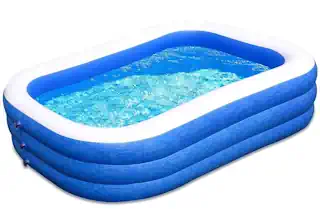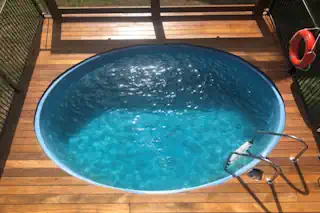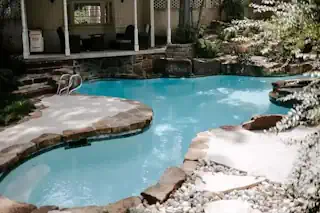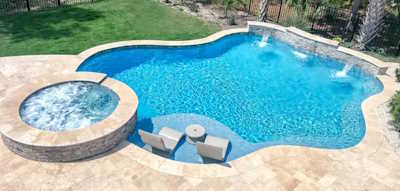Diving into the Future: The Rise of Natural Swimming Pools
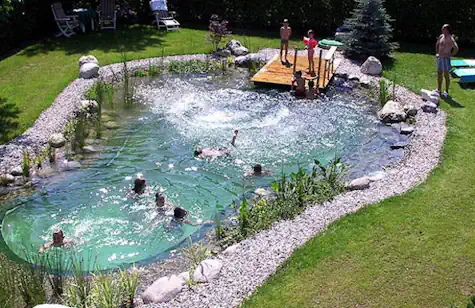
Swimming pools have long been synonymous with cool escapes and leisurely swims, but what if these aquatic sanctuaries could offer more than just a place to relax? Enter the thriving trend of natural swimming pools – a sustainable, picturesque, and health-conscious alternative to their conventional counterparts.
Riding the Wave of Eco-Friendly Trends
With an increasing emphasis on sustainability and our environmental footprint, industries across the board are innovating to offer greener solutions. In the realm of outdoor living spaces, natural swimming pools have surged in popularity, appealing to a demographic of environmentally conscious consumers.
Not just a fad, the demand for natural pools signifies a larger shift towards eco-friendly designs and organic materials. For homeowners, landscapers, pool owners, and pool enthusiasts alike, natural swimming pools epitomize the harmonious blend of nature and luxury.
What Defines a Natural Swimming Pool?
At its core, a natural swimming pool utilizes biological mechanisms to maintain water quality, eschewing the need for harsh chemicals and chlorine. These pools or ponds contain two distinct zones – one for swimming, and an adjoining regeneration zone, often a designated area for aquatic plants and beneficial microorganisms to thrive.
The principles of a natural pool hinge on recreating processes found in natural bodies of water, with water being circulated through the regeneration zone where it’s purified before returning to the swimming area. This cyclical process not only cleans the water efficiently but also creates a habitat for an ecosystem that supports diverse flora and fauna.
Natural pools are very different from traditional chlorinated pools, offering mineral-rich, clear water that is kinder to the skin and eyes. Additionally, they provide a more natural and picturesque setting for an enhanced swimming experience.
The Art and Science of Designing a Natural Pools
Creating a natural swimming pool involves a delicate balance of art and science. Landscape designers and pool specialists work hand in hand to conceive pools that are as beautiful as they are functional.
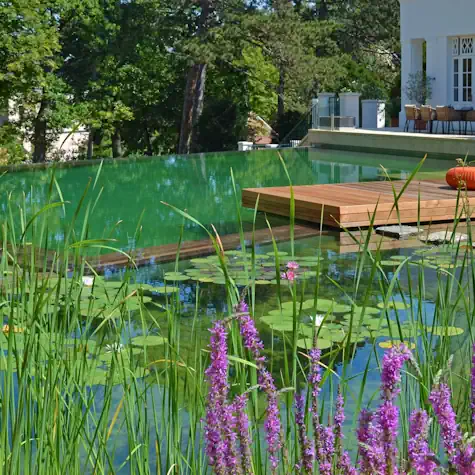
Top 10 Considerations for Designing a Natural Swimming Pool
Space Requirements: Evaluate the available space to accommodate both the swimming and regeneration zones.
Budget and Costs: Consider the initial investment and ongoing maintenance costs in comparison to traditional pools.
Local Climate: Design the pool to suit the local climate, including choosing plants that will thrive in your area.
Water Circulation: Plan for an efficient water circulation system to ensure the pool stays clean and healthy.
Regeneration Zone Planning: Allocate enough area for the regeneration zone, which typically requires at least as much space as the swimming zone.
Choice of Plants: Select aquatic plants not only for their purifying properties but also for aesthetics.
Wildlife Attraction: Be prepared for natural pools to attract wildlife, which can be a pro or con depending on personal preference.
Zoning and Regulations: Check local building codes and regulations to ensure compliance, especially regarding safety features.
Privacy Considerations: Design landscaping features for privacy without obstructing the natural beauty of the pool.
Professional Consultation: Engage with experts in natural pool design to avoid common pitfalls and ensure a successful project.
The key to the lake garden’s success lies in thoughtful site planning. Factors such as climate, the composition of the soil, and the availability of sunlight can dictate the size and placement of the pool. Furthermore, the integration of natural filtration systems is paramount. Skimmers and filter plants like water lilies serve as the frontline defense against impurities, followed by a series of sedimentation tanks and biological filters that ensure the water stays pristine.
Top 5 Natural Filtration Systems for a Natural Pool
Plant Filtration: Utilizes a variety of aquatic plants in the regeneration zone to naturally remove toxins, provide oxygen, and control algae. Plant species such as water lilies, cattails, and reeds are effective in purifying water through their root systems and are completely chemical-free.
Biological Filter: These include biofilms that form on rocks or gravel where beneficial bacteria can thrive. These bacteria are crucial for converting harmful ammonia and nitrates into harmless substances, effectively cleaning the water.
Skimmer Systems: Skimmers remove floating debris like leaves and insects before they sink and decay, which can affect water quality. They serve as a preliminary filtration stage that keeps the water’s surface clean.
Sedimentation Tanks: Designed to allow heavier particles to settle at the bottom while cleaner water flows towards the swimming zone. These tanks enhance the clarity and quality of water by physically removing sediments.
Natural Mineral Filters: Systems that use natural elements such as zeolite or volcanic rock can filter out impurities, absorb metals, and eliminate algae without the need for chemicals. They provide a way to maintain clear and healthy water through the adsorption of contaminants.
Aesthetic choices are equally crucial. Natural pools can be designed to mimic the look of a traditional pond or seamlessly blend into the existing landscape. Rocks, boulders, and carefully selected native plants create a sense of continuity with the natural environment.
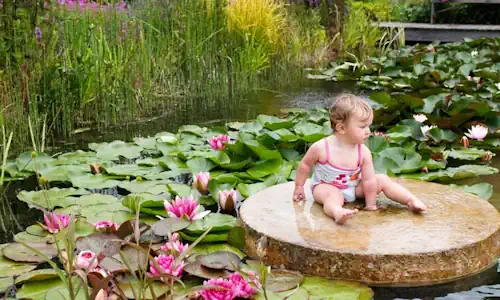
Top 5 Most Common Aesthetic Choices for Natural Pools
Natural Rock and Boulders: Incorporating rocks and boulders not only supports the pool structure but also adds a rugged, natural beauty that mimics wild aquatic environments.
Native Plantings: Selecting native plants for the landscape and regeneration zones ensures that the pool blends seamlessly with the local ecosystem, promoting biodiversity while enhancing aesthetic appeal. Floating plants similar to the surrounding landscape can be especially attractive.
Water Features: Adding waterfalls or streams can create a dynamic element to the pool, introducing soothing sounds and movement that enhance the natural feel.
Wooden Decks and Walkways: Using natural wood for decks and pathways around the pool area emphasizes a rustic charm and provides a warm contrast to the water and stone.
Subtle Lighting: The strategic placement of waterproof, low-impact lighting can illuminate the pool and its surroundings gently, making it inviting at night without disrupting the natural ambiance.
The Plunge: Switching Over from Traditional Pools
For those transitioning from a typical pool to a natural one, the switch from chlorinated pool can be as refreshing as the pool water itself. While the upfront cost of a natural pool may be slightly higher than a standard one, the long-term benefits more than makeup for it. Maintenance costs are significantly lower, as are the environmental impacts.
Owning a natural swimming pool calls for a different maintenance regimen. This includes semi-regular cleaning of the regeneration zone and monitoring of plant health. Seasonal variations, such as fluctuating temperatures, will impact the pool, calling for adjustments in care protocols. However, the hands-on approach to maintenance can be gratifying, as it deepens the connection with your pool and surrounding environment.
Case Studies in Natural Pool Pioneering
Across the globe, numerous success stories exemplify the prowess of natural pool design. From urban oases to rural retreats, these pools not only stand out for their beauty but also for their functionality. Take a look at some of these stunning marvels.
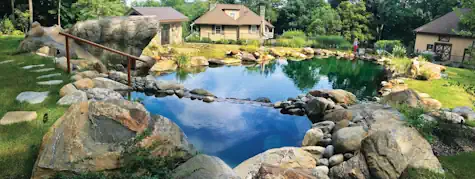
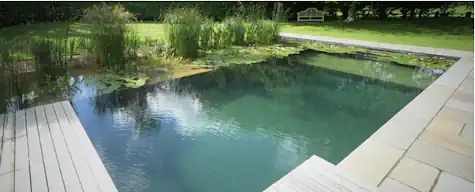
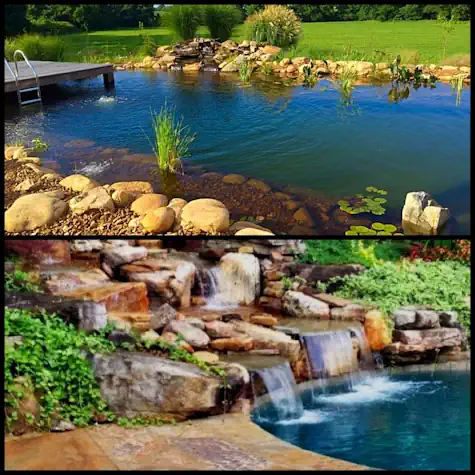
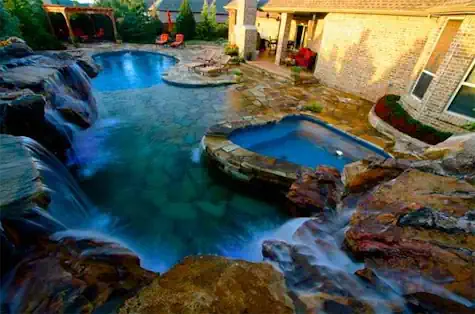
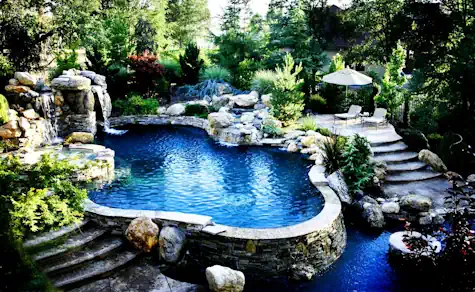
Toward the Tide of Mainstream Adoption
While natural swimming pools are rapidly gaining traction, their future in the market remains to be seen. Technological advancements and a growing body of supporting research continue to bolster the appeal of natural pool systems.
For industry professionals, the challenge lies in scaling these designs to make them more accessible without sacrificing quality or eco-credibility. The potential for natural swimming pools to redefine luxury living is immense, with the added allure of sustainability becoming increasingly attractive.
Testing the Waters: Should You Go Natural?
The decision to build or convert to a natural swimming pool is a personal one, but the environmental and health benefits are undeniable. For those considering making the switch from conventional pools, it’s a commitment to eco-friendliness and a step towards a more symbiotic relationship with nature.
The call to action is clear – explore the world of natural swimming pools, immerse yourself in their beauty and the conscientious practices that underpin their design, and consider the positive impact they could have on your lifestyle and the planet.
Frequently Asked Questions (FAQ)
How do natural swimming pools purify the water without chemicals?
Natural swimming pools utilize a combination of biological filtration and plant filtration to purify water. Beneficial bacteria in biofilms, along with a carefully selected array of aquatic plants, work together to remove toxins, provide oxygen, and control algae naturally.
Are natural swimming pools more expensive than traditional pools?
The initial setup cost of a natural swimming pool can be higher due to the complexity of integrating natural filtration systems and landscaping into the swimming pool. However, they often have lower long-term maintenance costs and environmental impact, making them a cost-effective choice over time.
Can natural swimming pools attract wildlife, and is this a concern?
Yes, natural swimming pools can attract wildlife due to their incorporation of live plants and more naturalistic designs. While some see this as a benefit, adding to the pool’s charm and ecological value, others may view it as a nuisance. It largely depends on personal preference and the balance of the ecosystem around the backyard or pool.
How do I maintain a natural swimming pool?
Maintenance of a natural swimming pool involves regular cleaning of the regeneration zone, monitoring plant health, and ensuring the filtration system is functioning properly. Unlike traditional pools, there’s no need for chemical treatments, but it does require vigilance to maintain the pool clean natural balance.
Can a natural swimming pool be heated?
Yes, natural swimming pools can be heated using environmentally friendly methods such as solar heaters. It’s important to consider the impact of heating on the traditional swimming pool’s ecosystem and to use sustainable heating solutions that complement the natural balance of the pool.
Is it possible to retrofit a traditional pool into a natural swimming pool?
While it can be more challenging than building a new natural swimming pool from scratch, it is possible to convert a traditional swimming pool. This process typically involves reshaping the existing pool, to include a regeneration zone and installing the necessary natural filtration systems. Consulting with a professional in natural pool design is essential for a successful conversion.
How long does it take to establish a natural swimming pool?
The time to establish a natural swimming pool water garden varies depending on size, design complexity, and climate conditions. On average, it can take a few months for the plants and ecological system to mature fully and for the water to achieve crystal clarity through natural processes.
